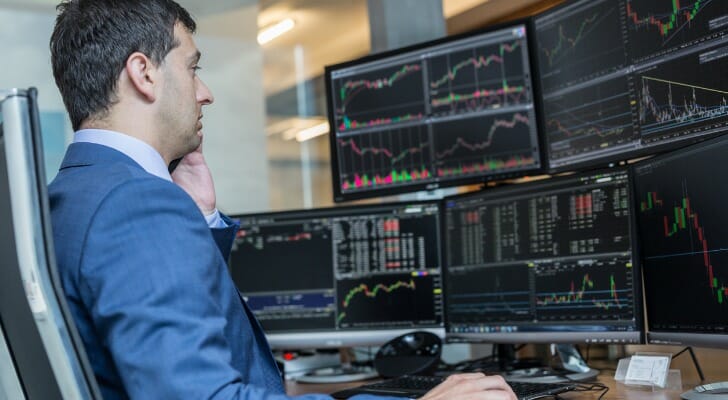High-Frequency Trading (HFT) is controversial. Some investors say it lets people capitalize on opportunities that vanish really quickly. Others say that HTF distorts the markets by processing large numbers of orders in fractions of a second. Regardless, this trading method uses algorithms to analyze multiple markets and identify investing opportunities based on those conditions. If you need help picking an investing strategy, consider working with a financial advisor to help you create an investing plan for all of your needs and goals. Let’s break down whether high-frequency trading is the right investment strategy for you.
High-Frequency Trading Explained
High-frequency uses computer programs and artificial intelligence to automate trading. This method relies on algorithms to analyze different markets and identify investing opportunities. And automation makes it possible for large trading orders to be executed in only fractions of a second.
The Securities and Exchange Commission (SEC) has set forth five trading characteristics common to this trading method:
- Use of extraordinarily high speed and sophisticated programs for generating, routing, and executing orders.
- Use of co-location services and individual data feeds offered by exchanges and others to minimize network and other latencies.
- Very short time-frames for establishing and liquidating positions.
- Submission of numerous orders that are cancelled shortly after submission.
- Ending the trading day in as close to a flat position as possible (that is, not carrying significant, unhedged positions overnight).
Why Engage In High-Frequency Trading?

High-frequency traders can conduct trades in approximately one 64 millionth of a second. This is roughly the time it takes for a computer to process an order and send it out to another machine. Their automated systems allow them to scan markets for information and respond faster than any human possibly could. They complete trades in the time it would take for a human brain to process the new data appearing on a screen (no less physically enter new trade commands into their system).
This creates many profitable advantages for the trader, but three stand out in particular:
Volume Trading
This system allows traders to profit off of a sheer number of trades that would be impractical or impossible for a manual trader. Through automation, a high-frequency trader can conduct enough trades in enough volume to profit off even the smallest differences of price.
Short Term Opportunities
High-frequency trading allows the investor to capitalize on opportunities that only exist for a short moment in the stock market. It also lets them be first to take advantage of those opportunities before prices have a chance to respond.
For example, say that a major investment firm liquidates one of its portfolios. Involved in this trade is approximately 1 million shares of Company X’s stock. In this case, the price per share for Company X would likely decline for a short time while the market adjusted to the newly released stocks. This dip could last for minutes or even seconds; not long enough for most manual traders to take advantage of, but plenty of time for an algorithm to conduct numerous trades.
Arbitrage Opportunities
Arbitrage is when you take advantage of the same asset having two different prices. For example, say in Town A soda sells for $1 per bottle while in Town B soda sells for $1.10. This would present an arbitrage opportunity. You could buy soda in Town A, then travel to Town B and sell it for the elevated price.
In most real world trading situations, however, arbitrage opportunities are difficult to come by. This is because the speed and reliability of global information networks means that most prices update in practically real time around the world.
However “practically” is the watchword. High-frequency trading can allow investors to take advantage of arbitrage opportunities that last for fractions of a second. For example, say it takes 0.5 seconds for the New York market to update its prices to match those in London. For half of a second, euros will sell for more in New York than they do in London. This is more than enough time for a computer to buy millions of dollars’ worth of currency in one city and sell it for a profit in the other.
Benefits of High-Frequency Trading
Beyond the benefits to the individual trader, many investors argue that high-frequency trading promotes both liquidity and stability in the marketplace. In particular, advocates say, this is because high-frequency trading can quickly connect buyers and sellers at the price each wants. (This is called the bid-ask-spread; essentially, the difference between how much a buyer wants to “bid” for an asset and how much the seller “asks” for it.)
Like all automated trading, high-frequency traders build their algorithms around the trading positions they’d like to take. This means that as soon as an asset meets a trader’s bid price, they will buy and vice versa for sellers with pre-programmed ask prices. This prevents inefficiency, which happens if traders can’t connect.
For example, assume that Peter held Stock A and wanted to sell it for $10. Susan wants to buy Stock A for $10. If the two connect, the stock will trade for $10. This arguably reflects its most accurate market price. However, if they can’t connect, Peter will reduce his price in order to find a buyer, selling Stock A for $9.50, arguably less than its actual market value.
High-frequency trading allows this process to happen more quickly, advocates say, letting buyers and sellers meet each other’s’ bid and ask prices far more often than they would otherwise.
Criticisms of High-Frequency Trading

Critics argue that high-frequency trading allows institutional investors (the kind who can afford this technology) to profit off a value that doesn’t exist.
For example, consider again our arbitrage case. The price of a euro is $1.10 in U.S. dollars. In London, trading pushes that price down to $1.08. Hypothetically say it takes 0.5 seconds for the market in New York to reflect that change, so for that half a second the price of a euro is two cents more expensive in New York than in London.
During that interval a high-frequency trader could buy hundreds of millions of euros in London then sell them near-instantaneously in New York, making two cents off each one.
In this case, the trader would have made millions of dollars off of no actual market value. This money would have been created purely off of software lag. And as a result, this faster-than-human trading could also have an adverse impact on the market.
Currency traders wouldn’t be blind to the sudden surge in activity around the euro and would react, causing the market to move in response to a series of trades made purely based around millisecond arbitrage.
Bottom Line
Supporters of high-frequency trading say it allows markets to find stable, efficient values at a fast pace. And they argue that this is particularly valuable for retail investors who simply do not have the time or the speed to execute orders on these opportunities.
Critics, however, point out that high-frequency trading distorts the markets. Institutional investors who have access to powerful computers can use this faster-than-human speed to execute trade orders that only have a momentary advantage, and could influence the market to react on trades that are based more on this automated trading method tha the actual values of the market.
Investment Tips
- If you aren’t sure if high-frequency trading is the right investment strategy for you, consider consulting a financial advisor. SmartAsset’s free tool matches you with financial advisors in your area in 5 minutes. If you’re ready to be matched with local advisors that can help you achieve your financial goals, get started now.
- High-frequency trading is only one strategy that investors use to manage their portfolios. Learn more about how professionals approach the market through our article on trading strategies.
- Day trading isn’t for everyone. But if you’re looking to move your money in and out of assets fast you’ll certainly need the right tools. Check out some of the best apps on the market for this hands-on approach to investing.
Photo credit: ©iStock.com/kasto80, ©iStock.com/Asia-Pacific Images Studio, ©iStock.com/NicoElNino
